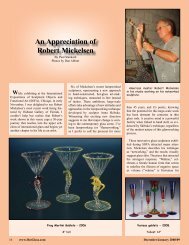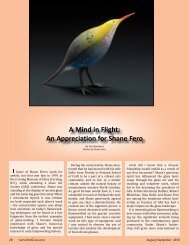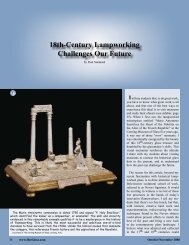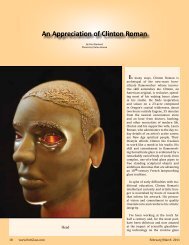What I Tell My Students Part II - Paul J Stankard
What I Tell My Students Part II - Paul J Stankard
What I Tell My Students Part II - Paul J Stankard
Create successful ePaper yourself
Turn your PDF publications into a flip-book with our unique Google optimized e-Paper software.
1971, stylized flower. The breakthrough<br />
for this piece was the center with upright<br />
stamens. Robin’s egg blue background<br />
was a popular color during <strong>Stankard</strong>’s<br />
part-time days. Photo: Courtesy of Joshua Steindler<br />
esting hurdles to overcome. Looking back,<br />
it’s sweet to remember what I was able to<br />
do with little equipment, and even though<br />
I benefited from 10 years of working with<br />
borosilicate glass, I loved the creative<br />
freedom and the wide-open possibilities<br />
of this new realm.<br />
While melting soda lime glass, there<br />
were times when the rod would pop and<br />
hot glass would fly around the utility<br />
room. It’s amazing I didn’t burn down<br />
our new house or get hurt, and I’m glad I<br />
didn’t give up on my dreams. The reason<br />
for the glass exploding was most likely<br />
poor annealing. The clear glass came<br />
from Kimble Glass Co. in Vineland, New<br />
Jersey, with the kind support of an executive<br />
named George Steer. George authorized<br />
a few old-timers in the hot shop to<br />
hand-pull the glass into three-foot lengths<br />
that were approximately one inch in diameter.<br />
This was in the ’60s, and Kimble had<br />
one of the few hand-shop furnace facilities<br />
left in South Jersey, which was once<br />
the center of our nation’s glass industry.<br />
I think back and marvel at how energized<br />
I was to learn paperweight making.<br />
The first paperweights had a variety of<br />
designs, from animals to flowers, and<br />
were influenced by the work of Charles<br />
Kaziun and Francis Whittemore, two contemporary<br />
paperweight makers from the<br />
’60s. Within a few months, I was focusing<br />
on flower blossoms and following a path<br />
for developing techniques to express my<br />
interests.<br />
Middle: 1971/2, stylized five-petal flower<br />
with upright stamens, spray of buds,<br />
curved stem with roots. The green glass is<br />
a mixture of yellow over blue over black.<br />
These personal techniques distinguished<br />
<strong>Stankard</strong>’s work.<br />
Bottom: 1973, floral motif interpreting<br />
native flower, Red Maid, suspended over<br />
white glass. Offers mottled red petals,<br />
green sequels, upright stamens, and rootlets<br />
off the stem. Photos: Courtesy of Joshua Steindler<br />
6 www.HotGlass.com Getting the most for your time & money<br />
April/May 2008







